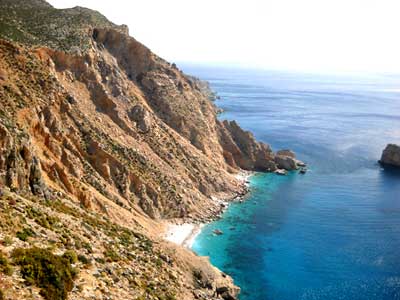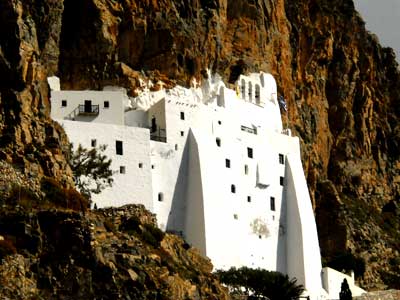Amorgos is 128 square kilometers in size and has around 2,000 permanent residents. The island in the Cyclades lies east of Naxos, somewhat off the routes of the large ferries. Amorgos is considered to be quite windy and mountainous. Although there are some beautiful beaches, the island is better suited for a hiking holiday than a beach holiday. Despite increasing numbers of holidaymakers, the island is still an insider tip for people looking for peace and quiet and a typical Greek island. Amorgos has many regular guests, which speaks for the island. Many northern Europeans come here because they are looking for an alternative to western city life. Quite a few stay for months or years.
Our articles about Amorgos |
|
| Amorgos Overview | |
| Katapola Amorgos | Aegiali Amorgos |
| Chora Amorgos | Chozoviotissa Monastery |
There are two port towns on Amorgos: Katapola and Aegiali. Katapola has more ferry connections and the nicer beaches in the area. Aegialis (also Aegiali) is the better starting point for hikes. Both towns have a few guesthouses, private rooms and taverns. A beautiful hike leads from Aegialis to the old main town of Chora in the centre of the island. Chora is a picturesque traditional village with little tourism. Worth seeing on Amorgos is the monastery of Panagia Hosoviotissa, built into a mountain not far from Chora.
The two main towns and Chora are connected by buses. In summer there are daily ferries to Piraeus (port of Athens), Naxos and Santorini. On many days there is also a ferry connection to the so-called “Small Cyclades” Iraklinqxa, Schinoussa, Ano Koufonisi and Donoussa, which lie between Naxos and Amorgos. Donoussa is considered by many to be the most beautiful of this group (about 100 inhabitants).
The Chesowiotissa monastery on Amorgos is a must-see. If you want to go inside: women must wear long skirts, men must wear long trousers. Daily opening times: 9 a.m. to 1 p.m., 5 p.m. to 7 p.m. It is inhabited by around 5-8 monks. It can be reached by bus.
The island of Amorgos became famous through the legendary French diving film “The Big Blue” from 1988. The film is still shown every day of the season on Amorgos.
Don’t have a hotel on Amorgos yet?There are many thousands of hotels on the islands of Greece. In our opinion, the best overview is on Booking.com. Here you can sort the accommodations by price or only display accommodations on a specific island. Hotels can be booked quickly and easily on Booking.com, and there are also many holiday apartments. |
Map of Amorgos (Greece)
If you zoom in on the map a bit, you can see the two port towns of Katapola and Aegiali.
The famous monastery is east of Katapola on the other side of the island.
There is also a road to the south of Amorgos that leads to the villages of Vroutsis, Rachoula, Arkesini and Kalofana. The northernmost village is Tholaria.
Great film about Amorgos
The film gives a good overview of the places and attractions of Amorgos island (English language).
Top 10 Amorgos for visitors to the island
Panagia Chozoviotissa Monastery
This 11th century monastery is built into a cliff and offers stunning views of the Aegean Sea. It is one of the island’s most famous landmarks and a must-see for history and architecture lovers. The absolute top attraction on Amorgos!
Agia Anna Beach
A beautiful beach known for its crystal clear waters and rocky landscape. It was featured in the film The Big Blue, making it a popular spot for visitors. Ideal for swimming and snorkeling.
Chora (“Town” of Amorgos)
The ancient capital of Amorgos is a charming town with narrow, winding streets, traditional Cycladic architecture and whitewashed houses. It is perfect for exploring local shops, cafes and historical sites.
Aegiali Bay
A picturesque bay with sandy beaches, turquoise waters and a relaxed atmosphere. There are several tavernas and cafes nearby.
Kalotaritissa Beach
This beach in the southern part of the island is known for its calm waters and is perfect for families. Nearby you can explore the sunken shipwreck of the “Olympia”.
Archaeological Site of Minoa
An ancient city with poor roots dating back to the Minoan civilization. It is a great place for history buffs who want to learn more about the island’s past.
Nikouria Island
A small, uninhabited island near Amorgos, known for its pristine beaches and excellent snorkeling spots. Nikouria is accessible by boat from Agios Pavlos.
Katapola
One of the main ports of Amorgos, offering a mix of traditional charm and modern amenities. It’s a great place to start a hike, enjoy local cuisine or take a boat trip.
Asphondylitis
A traditional abandoned village that offers a glimpse into the rural history of Amorgos. The old stone houses and impressive wall carvings create a nostalgic atmosphere.
Hiking
Amorgos is a hiker’s paradise with numerous trails offering stunning views of the sea, mountains and the island’s great scenery. Popular routes include the hike from Chora to Aegiali and the trail to Hozoviotissa Monastery.
Chozoviotissa Monastery
The Monastery of Panagia Chozoviotissa on the stunning island of Amorgos in Greece is one of the most remarkable and historically significant monasteries in the Cyclades. Built in the 11th century, it is nestled into the cliffs 300 metres above the Aegean Sea and offers spectacular views. Here’s what visitors need to know when planning a visit:
History and Significance
The monastery was founded in 1088 by the Byzantine Emperor Alexios I Komnenos. Local legend suggests that its origins go back even further. According to tradition, the icon of the Virgin Mary (Panagia) was found by a monk from Palestine who arrived in Amorgos. The monastery was built to protect the icon, which is believed to have arrived on the island by sea from the Hoziva region of Palestine.
The building itself is a feat of architectural ingenuity. Carved directly into the rock face, the narrow, white structure is eight stories high but only about five meters wide, blending seamlessly into the rocky landscape. It is like a symbol of faith and resilience to the harsh conditions of the island.
What to expect during the visit
Stunning views: The monastery offers stunning panoramic views of Amorgos, the sea and the surrounding countryside, making the challenging hike worthwhile.
Religious artifacts: Inside the monastery, visitors can see religious artifacts, ancient manuscripts and Byzantine icons, including the famous icon of Panagia Chozoviotissa.
Hospitality: Monks traditionally offer visitors rakomelo (a local honey liquor) and loukoumi (a sweet treat). Their warm hospitality adds to the spiritual experience of the visit.
Getting there:
The monastery is located about 3 km from Chora (Amorgos Town), the island’s capital. The entrance is a scenic climb of about 300 steep steps. As it is a moderately strenuous climb, it is advisable to wear comfortable shoes and bring water.
Visiting hours and dress code:
Opening hours: The monastery is usually open to visitors from 8:00 am to 1:00 pm and again from 5:00 pm to 7:00 pm. This was at least the case when we visited a few years ago. It is advisable to check in advance as opening hours may also vary slightly depending on the season.
Dress code: Due to the religious significance of the monastery, there is a strict dress code. Men should wear long trousers, while women should wear skirts that cover the knees and tops that cover the shoulders. Sarongs are often provided at the entrance if required.
Notes for monastery visitors:
Best time to visit: Early morning or late afternoon are ideal for visiting as temperatures are cooler and the light highlights the dramatic scenery.
Photography: While photography is permitted outside, it is restricted inside the monastery.
Respect for the site: The monastery is an active religious site. Visitors are expected to behave respectfully, for example by keeping noise to a minimum.
Movie The Big Blue
The Big Blue (1988), directed by Luc Besson, was partially filmed on the Cycladic island of Amorgos in Greece. The film is a fictionalized account of the rivalry and friendship between two competitive freedivers, Jacques Mayol and Enzo Maiorca. It features stunning underwater cinematography and picturesque Mediterranean landscapes, with Amorgos providing the backdrop for many of the film’s scenes.
Several notable locations in Amorgos appear in The Big Blue:
Agia Anna Beach: This small, rocky beach is one of the film’s most famous locations. The crystal clear waters and rugged cliffs create a dramatic backdrop, especially during the diving scenes.
Hozoviotissa Monastery: Perched on a steep cliff overlooking the sea, this monastery appears briefly in the film. It adds to the film’s sense of serenity and striking beauty.
Chora: The capital Amorgos, with its traditional architecture and narrow streets, can also be seen in the background of some scenes.
The film’s portrayal of the blue waters and tranquil surroundings contributed significantly to the island’s growing popularity.
How to get to Amorgos?
To get to Amorgos, one of the easternmost Cycladic islands, there are the following options:
1. Ferry to Amorgos
From Athens (Piraeus):
Ferries run regularly from Piraeus to the two ports of Amorgos: Katapola (central) and Aegiali (north).
Duration:
Fast ferry: approx. 6-7 hours.
Standard ferry: approx. 8-10 hours.
From other Cycladic islands:
There are connections from Naxos, Paros, Santorini, Mykonos and Syros to Amorgos (journey time varies depending on the starting island).
➔ To book ferries within Greece, we recommend the reputable website Ferryscanner.com
2. Flight + Ferry
There is no airport on Amorgos.
Fly to Santorini, Naxos or Paros → Take a ferry to Amorgos.
Summary:
Main connection: Ferry from Athens (Piraeus) or the Cyclades islands.
Important: Ferries often only run 1-2 times a day. Check the timetable, especially in low season.
What to do as a tourist on Amorgos?
Explore Chora
The capital Chora is a picturesque village with whitewashed houses, narrow streets, traditional taverns and small churches. A stroll through this authentic village is a must.
Visit the Monastery of Panagia Hozoviotissa
The iconic monastery, spectacularly hanging from a rock face, is one of the island’s most famous landmarks. Built in the 11th century, it offers stunning views of the Aegean Sea.
Swimming and snorkeling
Agia Anna: This bay is famous for its beauty and was used as a backdrop for the film The Big Blue.
Kalotaritissa: A quiet beach with crystal clear waters, ideal for relaxing.
Mouros: A beach with caves nearby that are ideal for snorkeling.
Hiking
Amorgos is a paradise for hikers. There are numerous hiking trails that connect villages, monasteries and beaches. The path from Chora to Hozoviotissa Monastery or from Aegiali to Tholaria is particularly recommended.
Discover the villages
Aegiali: A charming coastal village with tavernas, cafes and a beautiful beach.
Tholaria and Langada: Traditional mountain villages with an authentic atmosphere and fantastic views.
Visit the ancient city of Minoa
This archaeological site is located on a hill near Katapola and offers an insight into the history of the island.
Boat trips
From Katapola or Aegiali you can take boat trips to remote beaches or neighboring islands like Koufonisia.
Try local specialties
Enjoy typical dishes like patatato (a traditional stew), xerotigana (sweet pastries) and local rakomelo (honey raki).
Diving
Amorgos is a popular destination for divers. There are diving centers that offer guided tours to underwater caves and shipwrecks.
The sunset in Aegiali
The sunset from Aegiali is magical. An aperitif in one of the taverns makes the experience perfect.
11. Visit the Folklore Museum in Tholaria
Learn more about traditional life on Amorgos and the history of the island.
Do you have feedback, an addition, found an error or a comment? Send us an email to: mail@griechenland-insel.de

